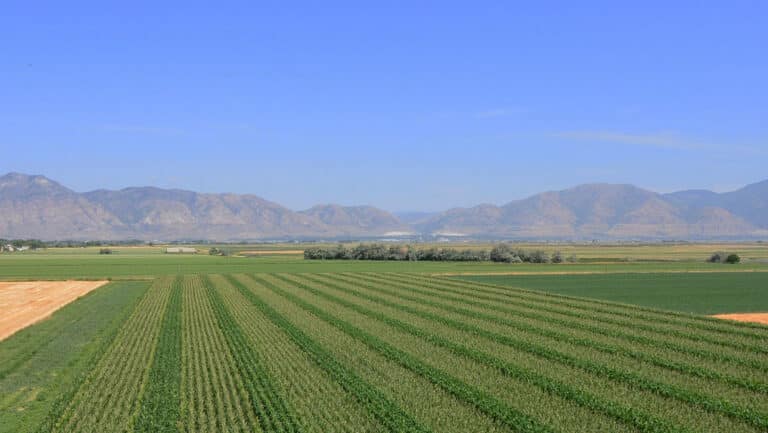Financial Incentives for Regenerative Agricultural Practices
Understanding the growing importance of sustainable farming for the U.S. ag industry.
Sustainability is a buzzword increasingly thrown around in the world of agriculture. The topic of sustainable agriculture is multifaceted, broad, and rich with varying perspectives. The implementation of sustainable methods usually comes with a high initial cost for farmers and ranchers but can pay off tenfold by reducing operational expenses, creating additional revenue opportunities, and reversing the consequences of a changing climate. Fortunately, more resources are being created each year to support the sustainable future for U.S. agriculture.
The textbook definition of sustainability means the ability to maintain at a certain rate or balance. For agriculture, sustainability is mainly discussed at an environmental and economic level. Legislators have taken steps to tackle this topic, recently introducing the Growing Climate Solutions Act of 2020, to help integrate environmental and economic sustainability through voluntary access to carbon markets. This has the potential to create a long-term revenue stream for American farmers and ranchers while reducing greenhouse gas emissions.
With an increasing world population and decreasing acreage of available rural lands, the topic of sustainable agriculture will only grow in importance over time. The rise of the regenerative agriculture movement has ignited a renewed hope in the future of agriculture as both a solution to climate change and a profitable business opportunity.
Sustainable vs. Regenerative Agriculture: What’s the Difference?
Sustainable agriculture incorporates a balance of regenerative and degenerative practices in order to maintain the way we grow our food while avoiding excessive depletion on an economic and environmental level.
Rather than maintaining agriculture where it is at now, regenerative agriculture makes improving the health of our natural resources a top priority while simultaneously improving the profit margins of farm operations across the country.
Sustainability implies a mission to keep agriculture alive in its current state, while regeneration implies enriching the future of agriculture moving forward.
Regenerative Agricultural Practice Being Implemented by U.S. Farmers and Ranchers
With ongoing research, American farmers and ranchers have begun achieving the win-win concept of regenerative agriculture with innovative solutions. The three most successful regenerative agriculture practices being implemented are anaerobic digestion, carbon sequestration, and precision ag technology.
Anaerobic Digesters
The process of anaerobic digestion produces biogas which can fuel mechanical power for heat and electricity. Although a high initial investment, anaerobic digesters pay for themselves over time. The subsidies and financial incentives available to create renewable natural gas make it a lucrative investment for farmers and ranchers.
Read how a farmer increased revenue through waste gas collection sales.
Carbon Sequestration
Carbon sequestration is an important part of the essential role American farmers and ranchers play in reversing the negative impacts of climate change. The carbon sequestration process in agriculture involves removing carbon dioxide from the atmosphere and storing it within the soil. This not only reduces carbon emissions but also improves degraded soils leading to more nutrient-rich crops. Soil carbon sequestration strategies include,
Through these practices, farmers and ranchers have improved soil stability, water drainage, and crop resilience. The regenerative potential of carbon sequestered soil is leading the push to make carbon markets more accessible to farmers through incentive programs and grants.
Precision Ag Technology
Increased adoption of farm technology—such as predictive nitrogen tools, UAVS/aerial imagery, and wireless weather stations—enables farmers to collect data that improves the efficiency of their operation. Through this technology, farmers can decrease water usage, monitor crop stress, and manage pest outbreaks more effectively.
Conservation Incentive Programs and Grants for Regenerative Agriculture
The cost and lack of resources available to implement regenerative agricultural practices are big deterring factors for American farmers and ranchers. Fortunately, more financial incentive programs are being created each year to ease the initial investment cost.
Rural Energy for America Program
The Rural Energy for America Program (REAP) provides financial assistance to farmers, ranchers, and rural small business owners to purchase, install, and construct renewable energy systems. These renewable energy efficiency improvements help reduce energy consumption and costs over time.
Biomass Crop Assistance Program
The Biomass Crop Assistance Program (BCAP) provides financial assistance to farmers, ranchers, and private rural landowners who wish to establish, produce, and deliver biomass feedstocks—a renewable energy source.
Conservation Technical Assistance Program
The Conservation Technical Assistance Program provides educational resources for rural landowners to address opportunities, concerns, and problems related to the use of natural resources and to equip them with the knowledge needed to make sound natural resource management decisions on their land.
Conservation Innovation Grants
Conservation Innovation Grants (CIG) are available to the public and private sectors for resource conservation efforts. CIG projects inspire creative problem solving that boosts the production of land by helping implement strategies to improve water quality, soil health, and wildlife habitat.
Supporting a Regenerative Future for American Agriculture
American farmers and ranchers have more access to regenerative farming practices through conservation incentives and grants, but barriers still exist. Additional educational and financial resources are needed—starting with increased broadband internet access in rural communities. An estimated one-third of rural communities lack broadband and are unable to capitalize on carbon markets without using the internet for data, information, and machine education.
Protecting our wildlife and natural resources has been a fundamental value for American farmers and ranchers for years as stewards of our farmlands, but many lack the resources needed to finance the initial investment of regenerative agricultural practices. AgAmerica believes in the long-term success of American agriculture and makes it our mission to provide the support needed through thriving times and the lean ones.
If you are interested in a partnership with an organization that goes beyond traditional agricultural lending and stands as an advocate for the future of American agriculture, please contact us today.






